Dry Eyes That Water: Causes, When to See a Doctor, and Treatment
What causes dry eyes that water? When should you see a doctor for watery eyes? What are the treatment options for persistent watery eyes? Get the answers.
Understanding Watery Eyes
Tears play a crucial role in keeping our eyes lubricated, washing away foreign particles, and protecting against infection. They are produced by glands under the skin of the upper eyelids and contain water and salt. When we blink, these tears spread across the surface of the eyes to maintain moisture.
Normally, excess tears are drained through the tear ducts and then evaporate. However, in some cases, the tear production can become excessive, overwhelming the drainage system and leading to watery eyes, also known as epiphora.
Common Causes of Watery Eyes
Watery eyes are a common condition and can be caused by a variety of factors, including:
- Dry eye syndrome: Extremely dry eyes can stimulate the overproduction of tears, leading to watery eyes.
- Environmental factors: Exposure to wind, cold, dust, and bright light can trigger excessive tear production.
- Eye strain: Prolonged use of digital devices or reading can strain the eyes and cause watery eyes.
- Infections and inflammations: Conditions like blepharitis (eyelid inflammation), conjunctivitis (pink eye), and blocked tear ducts can result in watery eyes.
- Medications and medical treatments: Certain prescription drugs, as well as chemotherapy and radiation therapy, can sometimes cause watery eyes as a side effect.
- Injury or irritation: Cuts, scrapes, or foreign objects in the eye can lead to watery eyes.
When to See a Doctor
In most cases, watery eyes are temporary and resolve on their own once the underlying cause is addressed. However, it’s important to seek medical attention if you experience any of the following symptoms:

- Vision loss or disturbances
- Injured or scratched eye
- Chemicals or foreign objects in the eye
- Red, irritated, swollen, or painful eyes
- Unexplained bruising around the eyes
- Tenderness around the nose or sinuses
- Eye issues accompanied by a severe headache
- Watery eyes that fail to improve on their own
Your doctor or eye specialist will perform a comprehensive eye examination and may conduct tests to determine the underlying cause of your watery eyes. This will help them provide the appropriate treatment.
Treatment Options for Watery Eyes
The treatment for watery eyes will depend on the underlying cause. Some common treatment options include:
- Prescription eye drops: These can help address issues like dry eye syndrome or eye infections.
- Treating allergies: Antihistamines or other medications can help reduce allergy-related eye watering.
- Warm, wet compresses: Applying a warm, wet towel to the eyes can help with blocked tear ducts.
- Surgical procedures: In some cases, a surgical intervention may be necessary to clear blocked tear ducts or create a new tear drainage system.
Preventing Watery Eyes
While it’s not always possible to prevent watery eyes, there are some steps you can take to reduce the risk:

- Limit exposure to environmental irritants like dust, wind, and smoke.
- Take regular breaks from digital screens and read
ing to reduce eye strain. - Use humidifiers to maintain proper moisture levels in the air.
- Practice good eye hygiene by gently cleaning the eyelids and removing any makeup before bedtime.
- Wear sunglasses or goggles when outdoors to protect your eyes from wind and bright light.
Conclusion
Watery eyes, or epiphora, can be a frustrating and persistent condition, but it’s important to understand the underlying causes and seek appropriate treatment. By addressing the root issue and making lifestyle adjustments, many people are able to find relief from their watery eye symptoms. If you’re experiencing prolonged or worsening watery eyes, don’t hesitate to consult with a medical professional for a proper diagnosis and personalized treatment plan.
Causes, When to See a Doctor & Treatment
Tears are normally discharged through your tear ducts and then evaporate. When you produce too many tears, they overwhelm your tear ducts, and you develop watery eyes.
Tears serve several key roles in your body. They keep your eyes lubricated and help to wash away foreign particles and dust. They are also a component of your immune system that protects you against infection.
Glands under the skin of your upper eyelids produce tears, which contain water and salt. When you blink, tears spread and keep your eyes moist. Other glands produce oils that keep tears from evaporating too fast or from spilling out of your eyes.
If you’re having too many tears, your watery eyes should resolve without treatment in most cases. But, the condition can sometimes become a chronic problem.
Consult your doctor if you have a prolonged case of watery eyes, especially if it is accompanied by other symptoms.
It is common to temporarily produce excess tears when you are emotional, laughing, coughing, vomiting, experiencing strong taste sensations, or yawning.
One of the most prevalent reasons for watery eyes is dry eye syndrome. Extremely dry eyes can cause you to produce excess tears. Because your eyes are not receiving proper lubrication, you continually produce an abundance of tears, which continues the cycle.
If your tears do not contain the right balance of water, salt, and oils, your eyes can become too dry. The resulting irritation causes an overproduction of tears that spill out through your tear ducts.
Among other common causes are:
- weather conditions such as dusty weather, wind, cold, and sunshine
- eye strain
- environmental factors such as bright light and smog
- common cold, sinus problems, and allergies
- inflammation of the eyelid (blepharitis)
- eyelid turned outward (ectropion) or inward (entropion)
- ingrown eyelash (trichiasis)
- pink eye (conjunctivitis) or other infections
- blocked tear ducts
- foreign objects, chemicals, or irritating gases and liquids in the eye
- injury, such as a cut or scrape on the eye
- some prescription medications
- cancer treatments, including chemotherapy and radiation
Typically, watery eyes are temporary and resolve on their own when the cause is addressed or your eyes have healed.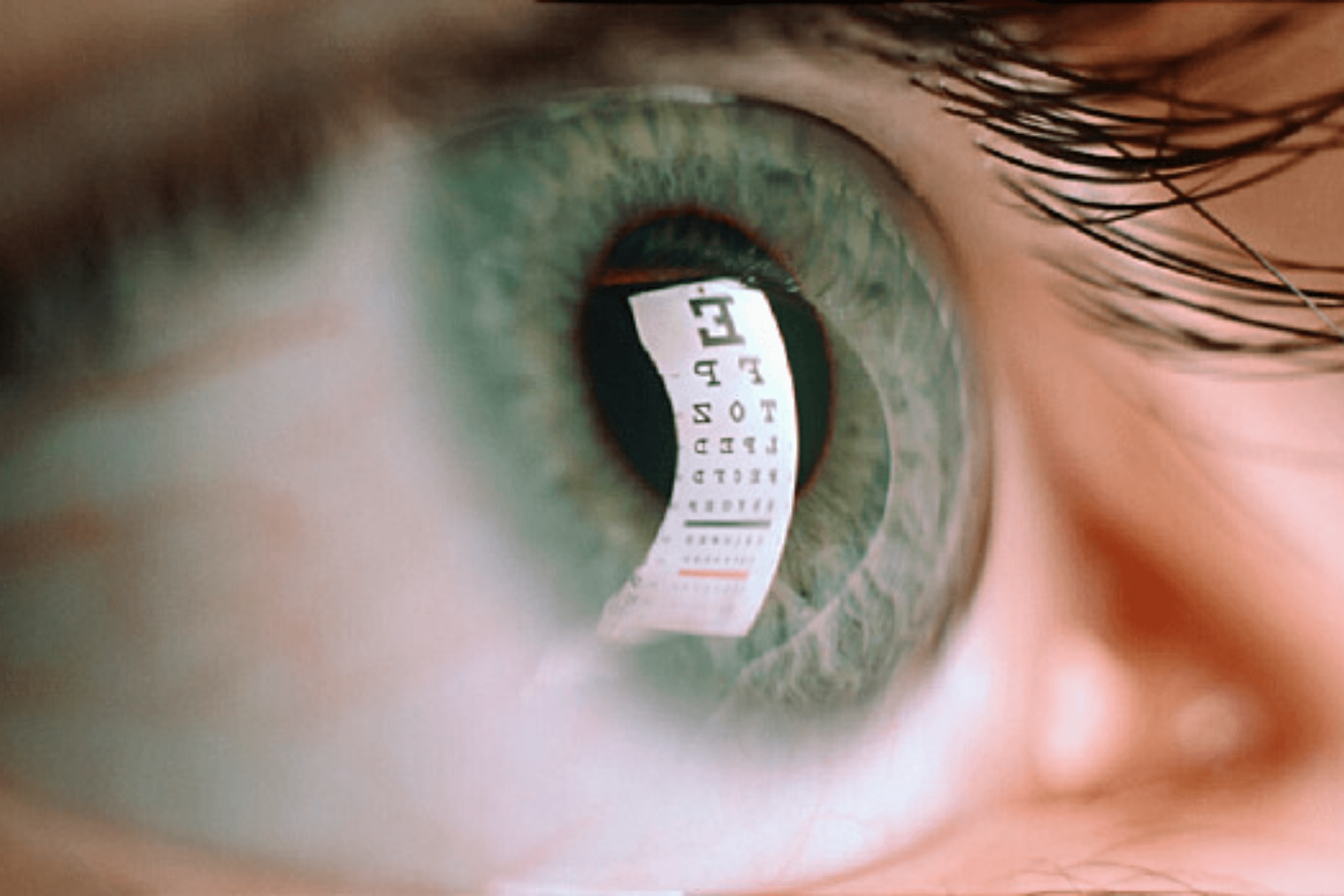 However, in some cases, the condition may persist.
However, in some cases, the condition may persist.
The reason for your dry eyes will determine the best treatment. You should contact a physician or eye doctor if you have excessive or prolonged tearing and any of the following symptoms:
- vision loss or visual disturbances
- injured or scratched eye
- chemicals in your eye
- discharge or bleeding from your eye
- foreign object stuck in your eye on the inside of your eyelid
- red, irritated, swollen, or painful eyes
- unexplained bruising around your eye
- tenderness around your nose or sinuses
- eye issues accompanied by a severe headache
- watery eyes that fail to improve on their own
In most cases, watery eyes will clear up without treatment. If not, your physician or eye doctor will perform an eye exam or a physical.
Be prepared to answer questions about recent eye injuries and health conditions. Tell your doctor about any prescription or over-the-counter medications or supplements you take.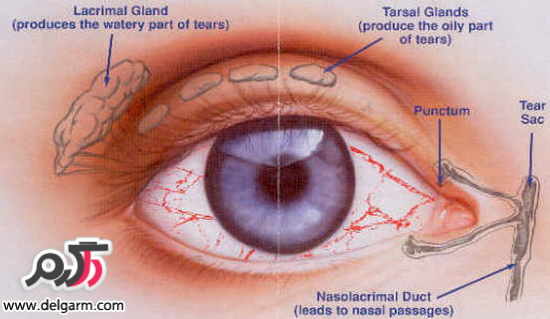
Your doctor may also perform a test that determines if fluid can pass through the tear ducts.
Remedies for watery eyes include:
- prescription eye drops
- treating allergies that make your eyes watery
- antibiotics if you have an eye infection
- a warm, wet towel placed on your eyes several times a day, which can help with blocked tear ducts
- a surgical procedure to clear blocked tear ducts
- surgery to repair or create a new tear drainage system (dacryocystorhinostomy)
Most cases of watery eyes aren’t serious and will resolve without treatment. You should always call your eye doctor right away if you experience any changes in your vision. Vision changes can be a symptom of very serious eye problems that require prompt treatment.
Epiphora (Watering Eyes): Causes and Treatment
Epiphora (Watering Eyes): Causes and Treatment
- Health Conditions
- Featured
- Breast Cancer
- IBD
- Migraine
- Multiple Sclerosis (MS)
- Rheumatoid Arthritis
- Type 2 Diabetes
- Articles
- Acid Reflux
- ADHD
- Allergies
- Alzheimer’s & Dementia
- Bipolar Disorder
- Cancer
- Crohn’s Disease
- Chronic Pain
- Cold & Flu
- COPD
- Depression
- Fibromyalgia
- Heart Disease
- High Cholesterol
- HIV
- Hypertension
- IPF
- Osteoarthritis
- Psoriasis
- Skin Disorders and Care
- STDs
- Featured
- Discover
- Wellness Topics
- Nutrition
- Fitness
- Skin Care
- Sexual Health
- Women’s Health
- Mental Well-Being
- Sleep
- Product Reviews
- Vitamins & Supplements
- Sleep
- Mental Health
- Nutrition
- At-Home Testing
- CBD
- Men’s Health
- Original Series
- Fresh Food Fast
- Diagnosis Diaries
- You’re Not Alone
- Present Tense
- Video Series
- Youth in Focus
- Healthy Harvest
- No More Silence
- Future of Health
- Wellness Topics
- Plan
- Health Challenges
- Mindful Eating
- Sugar Savvy
- Move Your Body
- Gut Health
- Mood Foods
- Align Your Spine
- Find Care
- Primary Care
- Mental Health
- OB-GYN
- Dermatologists
- Neurologists
- Cardiologists
- Orthopedists
- Lifestyle Quizzes
- Weight Management
- Am I Depressed? A Quiz for Teens
- Are You a Workaholic?
- How Well Do You Sleep?
- Tools & Resources
- Health News
- Find a Diet
- Find Healthy Snacks
- Drugs A-Z
- Health A-Z
- Health Challenges
- Connect
- Breast Cancer
- Inflammatory Bowel Disease
- Psoriatic Arthritis
- Migraine
- Multiple Sclerosis
- Psoriasis
Medically reviewed by Noreen Iftikhar, MD — By Noreen Iftikhar, MD — Updated on July 26, 2018
Overview
Tears help your eyes stay healthy and comfortable. However, uncontrolled tearing or watery eyes can impact your well-being and daily life.
However, uncontrolled tearing or watery eyes can impact your well-being and daily life.
Epiphora — more commonly referred to as watery eyes — is when you have excessive tear production. This can happen for a number of reasons. Your doctor can diagnose the cause, but let’s take a closer look at some of the possibilities.
Epiphora can cause your eyes to water slightly, or excessively with a constant stream of tears. You may also experience other symptoms in your eyes, such as:
- redness
- enlarged, visible blood vessels
- soreness
- sharp pain
- eyelid swelling
- blurred vision
- light sensitivity
Foreign objects and injury
When you get something in your eye, the resulting irritation can trigger sudden blinking and watering to flush it out. A speck of dust, dirt, or other material may cause an abrasion or scratch. A dirty or torn contact lens can also scratch or injure the eye, leading to epiphora. You may also feel grittiness, pain, or discomfort in your eye.
Allergies
Hay fever or allergic rhinitis is a common cause of epiphora. This happens when your body reacts to harmless substances such as pollen, dust, and pet dander. Your immune system makes antibodies to these allergens, triggering an inflammatory response that causes red, swollen, and watery eyes.
Infection and inflammation
Infections and inflammation of the eyes and eyelids can cause epiphora.
- Pink eye (conjunctivitis) is a common condition. It’s typically caused by a bacterial or viral infection in one or both eyes. As its name suggests, this condition causes inflamed blood vessels in the eye, giving it a pink or red look.
- The cornea, the clear lens of your eye, can become inflamed. This condition is called keratitis. Symptoms include pain, redness, blurred vision, sensitivity to light, and excess tearing and white discharge.
- An infection or inflammation in the lacrimal or tear glands can cause swelling and excess tearing.
- An ingrown eyelash can become infected causing painful swelling and watery eyes.

- A stye looks like a pimple or boil along the lash line. This painful red bump is usually caused by a bacterial infection of oil glands in the eyelid. Similarly, a chalazion is a smaller bump along the edge or underside of the eyelid that is not painful.
- Blepharitis is a red, inflamed swelling of the eyelids. This condition happens when the oil glands at the base of the eyelashes become clogged.
- Trachoma is a serious bacterial infection of the eye. This contagious condition is the leading cause of blindness in the world. Symptoms include itching, swollen eyelids, pus, and epiphora.
Tear duct obstruction
The nasolacrimal ducts are the tear ducts at the inside corner of each eye. They drain away tears to prevent the buildup of water in the eyes. These ducts can become blocked or narrowed, causing severe epiphora. This can affect one or both eyes. This condition affects babies, children, and adults.
The ducts can become blocked due to swelling, inflammation, and infection. Symptoms include eye swelling, redness, and tears that flow down the face.
Symptoms include eye swelling, redness, and tears that flow down the face.
Some types of obstructions are genetic. Punctal stenosis is a condition where the opening of the eye duct is narrowed or blocked.
Eyelid changes
Blinking your eyelids helps to evenly sweep tears on your eyes. Any changes in the structure and function of the eyelids can cause epiphora.
This may happen naturally or due to injury. Thinned and wrinkled eyelids in older adults can accumulate tears, causing redness and chronic watering.
An ectropic eyelid pulls away from the eyeball. This prevents tears from draining properly. An entropion eyelid is turned inwards. This can cause pressure, scraping, and discomfort in the eye, triggering epiphora.
Other causes
A number of other conditions can cause epiphora, including:
- dry eyes
- cold and flu
- sun and wind
- excess use of digital devices
- injury to the face
- injury to the nose
- sinus infection
Some medications may also cause epiphora:
- topical blood pressure drugs
- chemotherapy drugs (taxane)
- epinephrine
- eye drops (echothiophate iodide and pilocarpine)
- steroids
Your doctor or eye specialist will examine your eyes and both upper and lower eyelids to find the cause of the epiphora. A scope lets your doctor see the blood vessels behind your eye and check eye pressure. Your nose passages and sinus cavities may also be examined. Your doctor will look at your symptoms and medical history.
A scope lets your doctor see the blood vessels behind your eye and check eye pressure. Your nose passages and sinus cavities may also be examined. Your doctor will look at your symptoms and medical history.
If you have any discharge or pus from your eye, it may be tested to find out if you have a bacterial or viral infection.
Another test checks the chemical makeup of your tears. One clinical study found that people with epiphora had a lower number of particles in their tears.
Watery eyes may clear up without treatment. When necessary, treatment depends on the cause:
Foreign objects
Flush out the object with a gentle stream of clean water. Wash your hands with soap and water and remove contact lenses if you’re wearing them. See your doctor if you still have watering, pain, or any other symptom after the object is removed.
Allergies
Epiphora due to allergies is usually seasonal. Avoid known allergen triggers — such as pollen — during the spring months.
Relieve watery eyes and other allergy symptoms with medications. Allergy medications help to reduce an overactive immune response and ease symptoms. These include:
- antihistamines
- decongestants
- cromolyn sodium nasal spray
- immunotherapy
- eye drops
Infections and inflammation
Most viral eye infections clear up without treatment. Your doctor may treat a bacterial infection of the eye or eyelid with antibiotic drops or ointments.
Use a warm compress to soothe swelling and rinse the eye with sterile water to remove any crusting or discharge.
Blocked ducts and eyelid changes
Blocked tear ducts may clear up on their own or with antibiotic treatment for an eye infection. Use a warm compress with sterile water to help clear up any debris in the eyes.
In some cases, a blocked tear duct is treated with surgery to open up eye drainage. Eyelid changes may also be repaired with surgery.
A clinical trial found that injecting botulinum toxin may help to relax the muscles that close the tear ducts and treat epiphora.
Epiphora in newborn babies typically resolves on its own. Infant tear ducts can take up to a few months to fully open. You may need to clean the eyes with sterile wet cotton several times a day.
Watery eyes are common at any age. This condition is not always a cause for concern. Epiphora due to allergies, a cold, or an eyelid stye usually resolves on its own.
However, epiphora can also be a symptom of a serious infection. See your doctor urgently if you have epiphora along with pain, changes in vision, or a gritty sensation in your eyes.
Wash your hands regularly. Avoid touching your face to prevent spreading germs to your eyes.
If you wear contact lenses, you may be at higher risk of eye infections that lead to epiphora. Remember to wash your hands thoroughly before placing or removing lenses. Clean lenses daily. Replace old or expired contact lenses.
Protect your eyes and sight and help prevent epiphora with small, consistent changes. Wear sun protection when you’re outside. Reduce eye strain by wearing protective glasses and limiting your time looking at screens. Make complete eye exams a part of your regular health checkups.
Reduce eye strain by wearing protective glasses and limiting your time looking at screens. Make complete eye exams a part of your regular health checkups.
Last medically reviewed on July 26, 2018
How we reviewed this article:
Healthline has strict sourcing guidelines and relies on peer-reviewed studies, academic research institutions, and medical associations. We avoid using tertiary references. You can learn more about how we ensure our content is accurate and current by reading our editorial policy.
- Ali MJ, et al. (2014). Simple vs complex congenital nasolacrimal duct obstructions. DOI:
10.1002/alr.21435 - Bernardino RC. (2015). Evaluating epiphora.
reviewofophthalmology.com/article/evaluating-epiphora-nothing-to-cry-about - Mayo Clinic Staff. (2018). Watery eyes.
mayoclinic.org/symptoms/watery-eyes/basics/causes/sym-20050821 - Saleh G, et al. (2014). Tear film osmolarity in epiphora.
 DOI:
DOI:
10.1097/IOP.0b013e31825e6960 - Shin JH, et al. (2015). Impact of epiphora on vision-related quality of life. DOI: 10.1186/1471-2415-15-6
- Soiberman U, et al. (2012). Punctal stenosis: Definition, diagnosis, and treatment. DOI: 10.2147/OPTH.S31904
- Williams B, et al. (2014). Patterns and causes of epiphora referrals to a tertiary oculoplastic practice. DOI:
10.1016/j.jcjo.2013.12.003 - Ziahosseini K, et al. (2015). Botulinum toxin injection for the treatment of epiphora in lacrimal outflow obstruction. DOI: 10.1038/eye.2015.18
Share this article
Medically reviewed by Noreen Iftikhar, MD — By Noreen Iftikhar, MD — Updated on July 26, 2018
Read this next
- Why Are My Eyes Watering?
Medically reviewed by Ann Marie Griff, O.D.
Discover multiple causes of watery eyes, from weather conditions to producing too many tears. Also find out when to seek treatment.

READ MORE
- What Causes a Swollen Eyelid, and How Is It Treated?
How you treat a swollen eyelid depends on its cause. Learn about causes such as allergies and styes. Also discover home remedies and when to see a…
READ MORE
- What’s Causing My Eye Irritation?
Medically reviewed by Ann Marie Griff, O.D.
Eye irritation is a fairly common symptom that is often temporary and harmless. However, if you find your eyes are irritated often, you may want to…
READ MORE
- What Can Cause Your Eyes to Water When You’re Lying Down?
Medically reviewed by Leela Raju, MD
Your eyes are more prone to watering when you lie down since gravity can’t guide fluid toward your tear ducts. Here’s why, and what you can do about…
READ MORE
- Why Do My Eyelids Feel Dry?
Your eyelids may be more prone to skin conditions than other body areas. We’ll go over possible conditions, symptoms, home remedies, and when to see a…
READ MORE
- The 6 Best Stye Remedies
Medically reviewed by Lauren Castiello, MS, AGNP-C
Want to know how to get rid of a stye? We’ve got the answers with the most effective ways to treat and prevent styes, including home remedies and…
READ MORE
- Sleeping with Your Eyes Open: What You Should Know
Medically reviewed by Alana Biggers, M.
 D., MPH
D., MPHDo you wake up each morning feeling like there’s sandpaper in your eyes? If so, you could be sleeping with your eyes open.
READ MORE
- What Causes Dark Circles Under Your Eyes?
Are you worried about dark circles under your eyes? People often blame lack of sleep or stress, but there are many possible causes. Learn more here.
READ MORE
- Can Drinking Coffee Make Blepharitis Worse? Here’s What Experts Say
If you have blepharitis, drinking coffee may not make your symptoms worse. Here’s what to know about drinking coffee if you have blepharitis.
READ MORE
Dry eye syndrome: symptoms, signs, causes and prevention.
From Gary Heiting, OD
Dry eye syndrome results from a chronic lack of lubrication and moisture on the surface of the eye.
Dry eye symptoms range from mild but persistent eye irritation to significant inflammation and even scarring of the anterior surface of the eye.
As an alternative term for symptoms referred to as dry eye syndrome, dry eye disease, or simply
“dry eye,” the following medical terms are used:
Dry keratitis
Commonly used to describe dryness and inflammation of the cornea.
Keratoconjunctivitis sicca
Used to describe dry eye syndrome that affects both the cornea and the conjunctiva.Dysfunctional tear syndrome
Used to emphasize that insufficient tear quality is just as important as insufficient quantity.
Prevalence of dry eye syndrome
Dry eyes may become red, burning and irritated with a gritty feeling in the eyes.
Dry eye syndrome, also called dry eye disease (DED), is one of the most common eye diseases worldwide and a leading cause of eye visits.
In a review article published in the Journal of Global Health, researchers reported that the prevalence of dry eye syndrome is between 5 and 50 percent in various populations around the world. (According to the authors of the study, such a wide range may be due to different diagnostic criteria in different studies, the unique characteristics of the studied populations and other factors).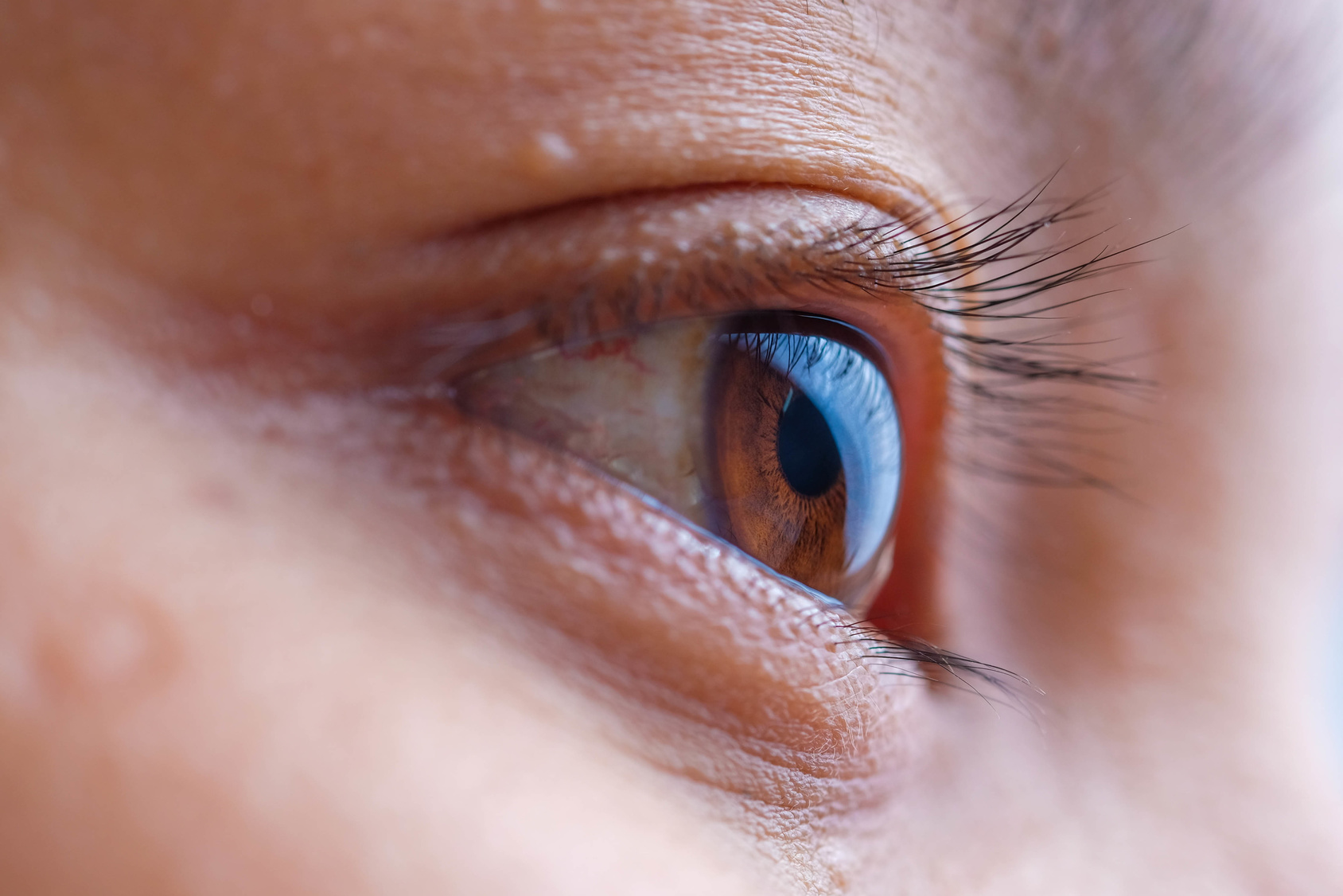
Risk factors for dry eye syndrome included older age, female gender, and computer use.
Dry eye symptoms
Dry eye symptoms and dry eye syndrome:
Another common symptom is a foreign body sensation, like sand or some other object or material in your eye.
As strange as it may sound, watery eyes can also be a sign of dry eye syndrome.
This is because the dry surface of the eye in some cases activates a protective mechanism that stimulates excessive production of the watery component of tears. But the duration of “reflex lacrimation” is not enough to eliminate the main cause of dry eyes.
In addition to these symptoms, dry eyes can lead to inflammation and (sometimes permanently) damage to the surface of the eye.
Dry eye syndrome can also affect the effectiveness of LASIK laser vision correction and cataract surgery.
What causes dry eye syndrome?
Sufficient and constant wetting of the surface of the eye with tears is necessary to maintain the health and comfort of your eyes and good vision.
Tears wash the surface of the eye, moisten it, and wash away dust, foreign particles and microorganisms that can damage the cornea and lead to eye infection.
The normal tear film consists of three important components:
Fat (lipid) component
Aqueous (water) component
Mucous (mucin) component 9 0003
Each component of the tear film plays an important role. For example, tear lipids prevent the tear film from evaporating too quickly and provide lubrication, while mucin helps to hold and evenly distribute tears on the surface of the eye.
Each tear component is produced by different glands located directly in or near the eye:
The fatty component is produced by the meibomian glands of the eyelids.
The aqueous component is produced by the lacrimal glands located inside the upper eyelids.
The mucin component is produced by the goblet cells of the conjunctiva, which lines the white of the eye (sclera).

Malfunction of any of these organs can lead to tear failure and dry eyes.
SUFFERING FROM DRY EYES? Find an optometrist nearby .
Varieties of dry eye syndrome
Depending on which organ is affected, there are different types of dry eye syndrome.
For example, if the meibomian glands do not produce or secrete enough fat (meibum), the tear film will evaporate too quickly—so-called “evaporative dry eye” syndrome occurs.
At the same time, in many cases, when making a diagnosis of dry eye syndrome, it is possible to determine the underlying disease – dysfunction of the meibomian glands.
In some cases, dry eye syndrome is caused by the inability of the lacrimal glands to produce enough watery fluid to keep the eyes properly moist. This condition is called “dehydrated dry eye” syndrome.
A type of dry eye often
determines the type of treatment your eye doctor will prescribe to relieve symptoms.
Factors associated with dry eye syndrome
Many factors can increase the risk of developing dry eye. For example:
Working at a computer
When we work on a computer, using a smartphone or other portable digital device, we tend to blink our eyes less and less, which leads to more evaporation of tears and increases the risk of dry eye symptoms.
Contact lens wear
Although there is no clear relationship between contact lens wear and dry eye syndrome, dry eye discomfort is the main reason people stop wearing contact lenses.
Aging
Dry eye syndrome can occur at any age, but it becomes more common in later life, especially after 50 years of age.
Menopause
Postmenopausal women are at greater risk of developing dry eyes than men of the same age.
Room temperature and humidity
Air conditioning, ceiling ventilation, and forced air heating can reduce indoor humidity and/or accelerate the evaporation of tears, causing dry eye symptoms.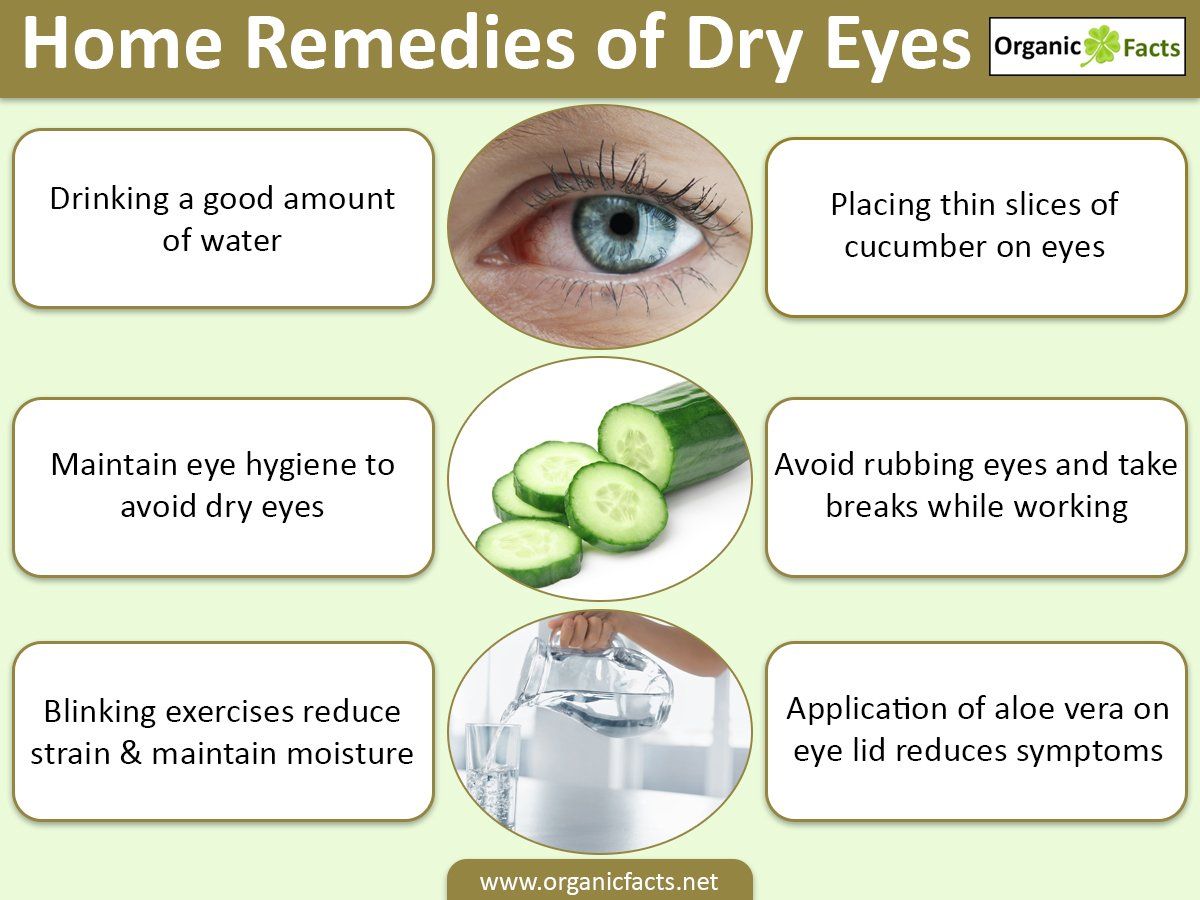
Outdoor environment
Arid climates and dry or windy conditions increase the risk of dry eye syndrome.
Frequent flights
Aircraft cabin air is virtually devoid of moisture and can cause dry eyes, especially for frequent flyers.
Smoking
In addition to dry eyes, smoking causes serious vision problems, including macular degeneration, cataracts and uveitis.
General health
Some systemic diseases such as diabetes mellitus, thyroid disease, lupus, rheumatoid arthritis and Sjögren’s syndrome contribute to the development of dry eyes.
Drugs
Many prescription and over-the-counter medications, including antihistamines, antidepressants, some blood pressure medications, and birth control pills, increase the risk of dry eye symptoms.
Eyelid problems
As a result of aging, cosmetic blepharoplasty or other causes, incomplete closure of the eyelids when blinking or sleeping (lagophthalmos) can occur, which if left untreated can lead to a corneal ulcer.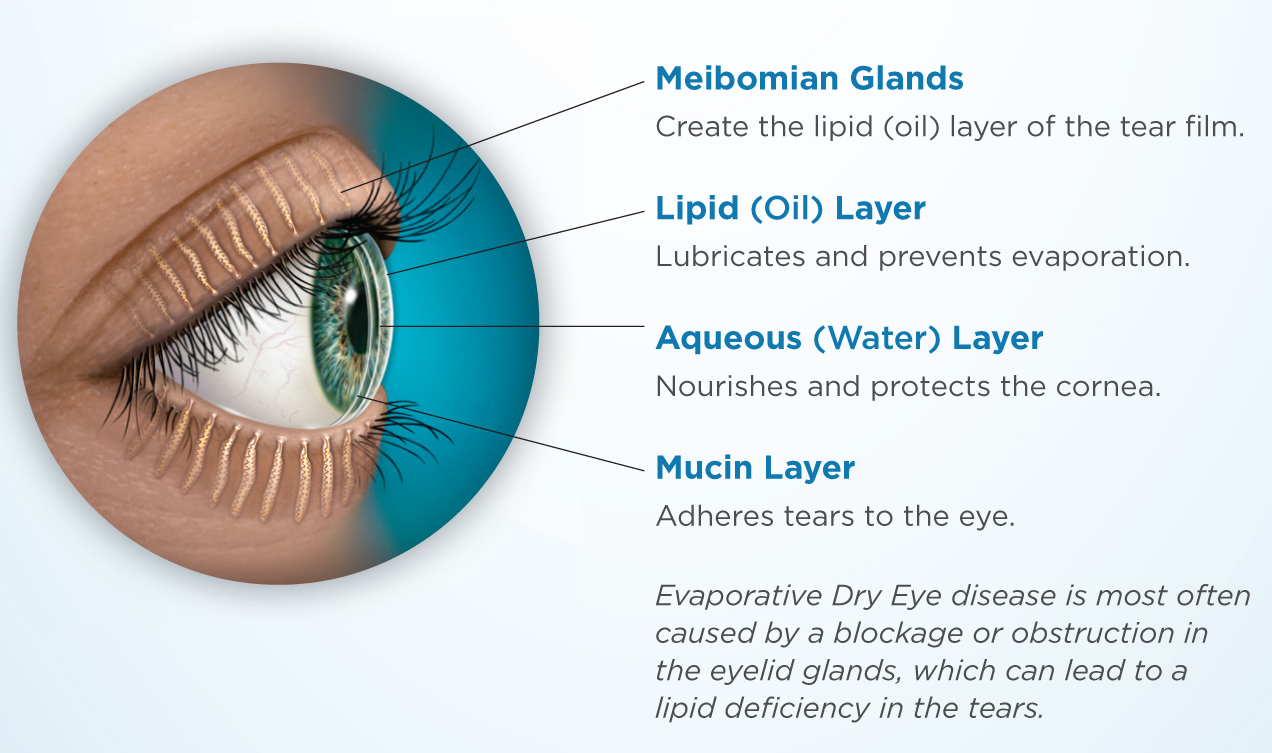
In some cases, dry eyes can be associated with LASIK laser vision correction and other corneal refractive surgery. In most cases, dry eye discomfort after LASIK vision correction is temporary and resolves within a few weeks after the procedure.
If you have dry eye and are considering LASIK, your optometrist may prescribe a dry eye treatment program for you to get the best results.
Dry eye news
Link found between smartphone use and dry eyes in schoolchildren it turned out that this may be the cause of the development of dry eye syndrome in children at an early age.
Korean researchers assessed risk factors for dry eye syndrome among schoolchildren who used video devices, including smartphones.
916 students in grades 1-6 were examined for signs of dry eye syndrome. Questionnaires were analyzed in which children and their parents indicated the types of video devices often used by children (computer, smartphone and TV), as well as the amount of time they spent on each video device.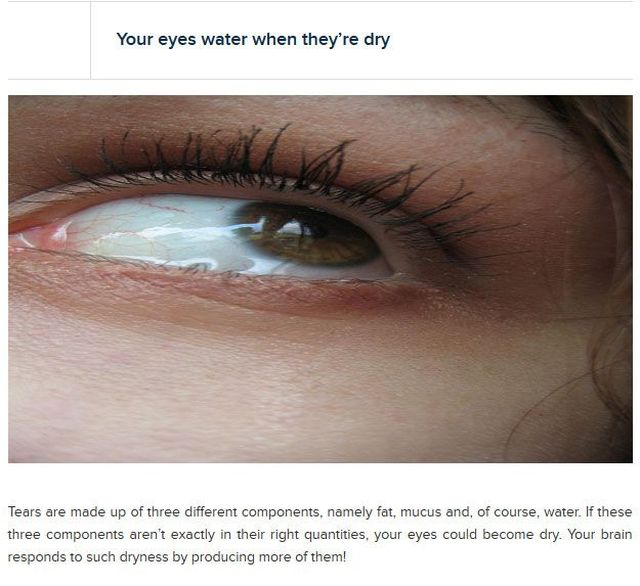 Data were also collected on the amount of time children spent outdoors.
Data were also collected on the amount of time children spent outdoors.
Overall, 6.6 percent of children were found to have signs of dry eye syndrome. Pathology was detected more often in children living in the city than in rural areas (8.3 percent versus 2.8 percent). In terms of frequency of smartphone use, 61.3 percent of children living in urban areas and 51.0 percent of children living in rural areas used them.
Based on age, HSD was diagnosed in 9.1 percent of children aged 9 to 12 compared to 4.0 percent of children aged 6 to 9years. Among older children, 65.1 percent used smartphones, while among younger children it was 50.9 percent.
In addition, children with dry eye syndrome used smartphones longer than children who did not have the disease. After children with dry eye stopped using smartphones for 4 weeks, there was a decrease in subjective symptoms and objective signs of dry eye.
The authors of the study concluded that the use of smartphones by children is strongly associated with dry eye disease in children. High school students living in the city had the highest risk factors and incidence rates for dry eye syndrome.
High school students living in the city had the highest risk factors and incidence rates for dry eye syndrome.
The authors also noted that signs and symptoms of dry eye decreased after smartphone use was discontinued, and increased time spent outdoors appears to be a good prevention of dry eye disease in children.
Dry Eye Diagnosis
The only way to know for sure if you have chronic dry eye syndrome is to have your optometrist run one or more dry eye tests during your eye examination.
Symptoms in this case are not an adequate predictor of the presence and severity of dry eye syndrome. In different people, the symptoms can vary significantly and even depend on the type of personality.
For example, people with minimal or mild dry eye may be very concerned about their eyes, while others may have severe eye disease but do not consider their symptoms serious enough to see an optometrist (or no symptoms at all). dry eyes).
Only a thorough examination of your eyes by an optometrist can reveal the presence of dry eye syndrome and its severity, as well as help the optometrist in each case choose the best type of treatment for the health, comfort of the eyes and good vision.
Treatment and prevention of dry eye
Fortunately, there are effective treatments for chronic dry eye.
In many cases, regular use of a tear substitute, as well as minor behavioral changes (such as frequent breaks while working at the computer), can significantly reduce dry eye symptoms.
In some cases, your optometrist may prescribe prescription eye medications and outpatient treatments to help your body make and release more tears, reducing irritation and inflammation in your eyes.
Page published Thursday, November 12, 2020
Dry Eye Syndrome: 7 Causes and Treatments
Health
Column
November 20, 2019
Dry eyes threaten those who spend a lot of time in front of a computer or smartphone screen – that is, almost all of us.
Igor Aznauryan
Ophthalmologist, Academician of the Academy of Medical Sciences, Doctor of Medical Sciences. Chief Physician of the network of eye clinics “Yasny Vzor”.
Modern ophthalmologists have found out who most often suffers from dry eye syndrome. These are those who spend a lot of time in front of gadget screens.
Many people may not even be aware of their diagnosis. We will suggest symptoms:
- sensation of sand and dust in the eyes;
- thread;
- burning;
- causeless lacrimation;
- I often want to rub my eyes.
Doctors test for dry eyes in another way, the Schirmer test. This is an examination that shows the amount of tears. Under the eyelids, special pieces of paper are inserted that absorb the tear. It is painless, takes a minute and gives an accurate result.
Schirmer test
Before discussing directly the causes of dry eyes, let’s figure out how it should be normal. Fully moistened – a tear is responsible for this, which constantly washes the eye. And here there is an important nuance – the quality of the tear.
Yes, tears can be of good quality and sometimes not. There are two components in a tear: water and fatty (lipid). The balance of these components is a quality tear. If the balance is disturbed, dry eyes occur.
There are two components in a tear: water and fatty (lipid). The balance of these components is a quality tear. If the balance is disturbed, dry eyes occur.
Now let’s look at the causes of this condition.
What causes dry eye syndrome
1. Gadget screens
Any screen means a computer, tablet or phone. If you look at any screen for too long, the eye begins to dry out. The fact is that bright light makes us focus and peer more carefully. We are too involved, and the eyes simply “forget” to blink. The fact is that blinking is an unconditioned reflex, we don’t think about it. And this reflex slows down when our attention is overly focused on something.
2. Dry air
We have dry air everywhere. In the office and at home, batteries work in winter, and air conditioning in summer. And on the street: just remember what it’s like to walk in the heat – something dries in the throat, not like in the eyes.
Dry air dries up the tear that should wash the eye.
And it is even more dangerous than a computer screen.
Few people know that our cornea (this is the transparent outer shell of the eye) does not have blood vessels, that is, it is powered by tears. For example, a tear should deliver oxygen to her. And how will she do it if she dries out under the influence of dry air? The less oxygen and nutrients the cornea receives, the worse its condition.
3. Hormones
This reason is purely feminine. During menopause, which can begin at a fairly early age, the amount of estrogens in a woman’s body decreases. These hormones affect the metabolism of fats. Including they reduce the amount of fatty component of tears. This means that the consistency of the tear changes, it becomes more liquid, it cannot stay on the eye. In such cases, women may begin causeless lacrimation.
4. Contact lenses
Even if you remember to remove your lenses at night, if you change them every day and you are sure that your containers are sterile, you still cannot avoid dry eyes.
Long lens wear = dry eye syndrome. This is an axiom. Lenses disrupt the layers of tears, degrade its quality and dry out the eye.
Ideally, you should wear lenses not every day, but only when necessary. Of course, for a person with poor eyesight, this is simply impossible. Swap lenses for glasses? Again, this is inconvenient for many.
Therefore, if you have poor eyesight, there are two ways out:
- Ask your doctor to prescribe an artificial tear for you and constantly drip it into your eyes.
- Get laser vision correction if you have no contraindications and forget about lenses. However, the preparation for the operation must be done correctly – see the next paragraph.
5. Laser vision correction
Dry eye syndrome often worsens after laser vision correction. But this happens if the preparation for the correction was carried out incorrectly. Before the operation, the aforementioned Schirmer test, a dry eye test, should be done.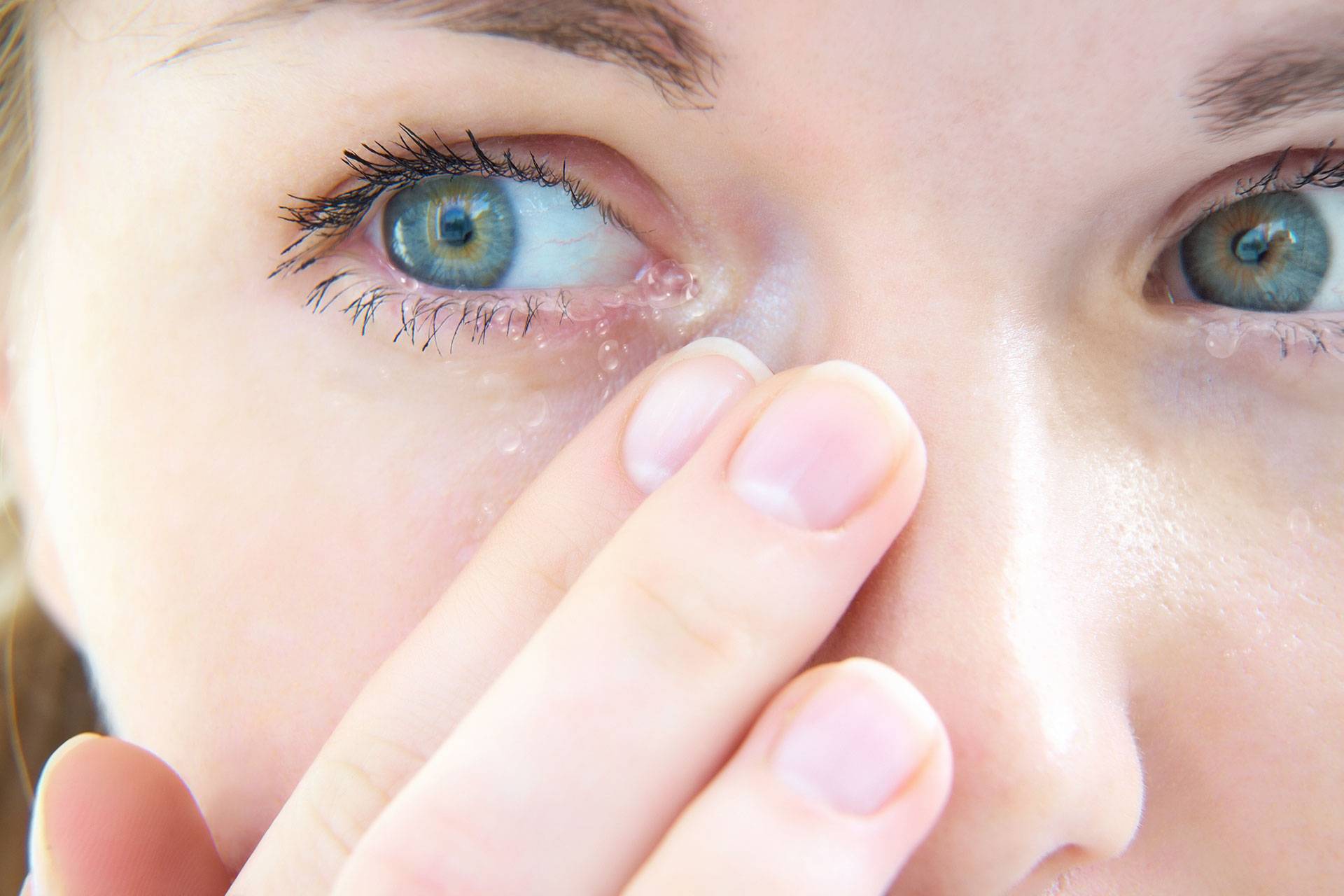 And if necessary, treat this syndrome, but not with drops, but with more effective laser stimulation. If this technology is observed, then laser correction will pass without problems.
And if necessary, treat this syndrome, but not with drops, but with more effective laser stimulation. If this technology is observed, then laser correction will pass without problems.
6. Medicines
Some medicines cause dry eyes. These are usually antidepressants and oral contraceptives. Drugs affect the hormonal background, which, in turn, affects the fatty component of the tear. The tear film loses its stability and the eye dries out. In parallel with taking these drugs, it is better to use artificial tears.
7. Chronic diseases: diabetes, conjunctivitis, blepharitis
Diabetes mellitus , in addition to many other unpleasant consequences, also causes dry eyes. But with proper compensatory therapy, this problem does not arise.
In the treatment of conjunctivitis , antibiotics are used that interfere with the quality of the tears. Therefore, after the treatment of this disease, it is imperative to be treated for dry eye syndrome.
Blepharitis is a chronic inflammation of the eyelids that also impairs the quality of tears. Until it is treated, dry eyes will not go away.
How to treat dry eye syndrome
- Use artificial tear drops. However, an independent choice of drops, although it will not bring harm, but also benefits: now there are drops with different compositions, so the doctor should choose the ones that are right for you.
- Get laser treatment. Modern ophthalmologists treat dry eye syndrome not only with drops. Circulatory laser stimulation of the lacrimal glands is a type of physiotherapy that improves the production and composition of tears. Moreover, unlike drops, one course of treatment is enough for at least six months.
- Treat comorbidities leading to dry eye syndrome.
- Buy a humidifier.
- Set an alarm every 10 minutes while working on the computer. This will be a signal that it is time to blink properly.
- For contact lens wearers, laser vision correction if there are no contraindications.



 DOI:
DOI:
 D., MPH
D., MPH

 And it is even more dangerous than a computer screen.
And it is even more dangerous than a computer screen.